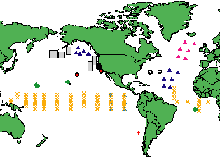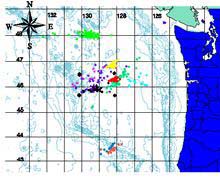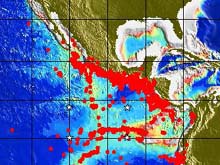
The Pioneer Seamount hydrophone array (Black Dot) is the first in a series of planned installations by the Sound in the Sea Project. This map shows sites currently being monitored by NOAA and its partners (filled symbols) and future potential sites (light symbols). The red triangles south of Iceland, and the red dots in the eastern Pacific, are all sites planned for integration into the network in the coming years. Click image for larger view.
Mission Plan
Chris Fox, Director
Acoustic Monitoring Project
NOAA Pacific Marine Environmental Laboratory
Sound in the sea, which oceanographers refer to as “underwater acoustics," offers the most effective means of exploring a wide variety of natural phenomena over large regions of the global ocean. The unique properties of temperate and tropical seas result in a permanent layer in the ocean in which sound energy can propagate over great distances with very little signal loss. By placing underwater listening devices (hydrophones) within this layer, sound can be monitored from distances ranging from hundreds to thousands of kilometers.
Perhaps the most powerful natural sources of sound in the seas are the seismic waves generated by earth movements. These can be generated within submarine transform fault zones, similar to the San Andreas Fault in California, which are found throughout the 60,000 km of sea-floor spreading centers encircling the globe. Deep-sea trenches, or subduction zones, which ring the entire Pacific Ocean as well as isolated areas in other oceans, can generate earthquakes with magnitudes of 9 or greater. Submarine volcanoes generate a lower level of seismic energy, but can still be heard across the entire North Pacific Ocean, and can produce hundreds of these small earthquakes per hour. Other geological phenomena, such as submarine landslides, can also be detected, identified, and located using underwater acoustic methods.
Non-geological sources of sound in the sea include biological “vocalizations” by whales, dolphins, and fish. Each species has distinct calls that can be recognized and monitored to observe animal migrations, help estimate abundances and the general increase or decline of populations, and study the behavior and interaction of marine fauna. In addition, the breakup and calving of ice, (e.g., sea ice of continental ice masses such as on Antarctica and Greenland), can be heard over great distances. Meteor impacts have also been recorded acoustically. Meteorological phenomena such as wind, precipitation, surface waves, and lightning strikes add to the overall ambient noise of the oceans.
Although sound in the sea is an ideal method for studying natural phenomena in the oceans, nearly all of the scientific research performed since World War II has been conducted by the military. This is due to the value of underwater acoustic surveillance in war fighting on the open seas, particularly in anti-submarine warfare. During the 1960s, 70s and 80s, the U.S. Navy installed large networks of hydrophone arrays around the world ocean to monitor the movements of submarine forces of the Soviet Union. Following the fall of the Berlin Wall in 1989, the U.S. Navy allowed access to some of these hydrophone arrays to evaluate their potential for civilian scientific applications.

Some of the most readily detected signals on the U.S. Navy's SOund SUrveillance System (SOSUS) in the North Pacific are those produced by the blue whale. This distinctive call allows the use of mathematical matched filters to detect the signal within the ocean's ambient noise, and to determine the location of calls to within a few km from areas that are hundreds of km away. This image includes locations of blue whale vocalizations for selected days in September 1994, based on SOSUS acoustic detections. Different colors denote detections on different days. Click image for larger view.
At least three major programs were conducted during the 1990s to assess the use of military hydrophone arrays to environmental science applications. The first was conducted by NOAA’s Vents Program in Newport, Oregon, to explore for volcanic activity along the Juan de Fuca Ridge spreading center offshore of the Pacific Northwest and northern California. Using Navy hydrophone arrays, Vents scientists successfully detected, identified, and located three major submarine volcanic eruptions in the northeast Pacific, which were subsequently confirmed by field observations. The project has also monitored general seismicity throughout the North Pacific basin, recorded landslides offshore of Hawaii, and monitored other natural phenomena during its decade- long effort.
NOAA, the Woods Hole Oceanographic Institution, and Cornell University have conducted scientific studies of large marine mammals, in particular blue whales, in both the Pacific and Atlantic. These studies led to a fundamental understanding of the distribution of large whales in the deep ocean, a difficult topic to observe by any other means. Finally, underwater acoustics formed the basis of ATOC, the Acoustic Thermometry of Ocean Climate experiment. This multi-institutional effort, led by the University of California at San Diego, showed that acoustic transmissions could be accurately timed over global distances, and, ultimately, could be related to long-term changes in ocean temperature due to climate change.
Natural phenomena are not the only source of sound in the sea. Since the beginning of the Industrial Revolution in the 1850s, man has become an increasingly significant producer of ocean noise. Today’s supertankers and container ships, which evolved from the streamships of the Industrial Era, contribute a nearly constant background drone in the world’s oceans, particularly along the well-defined trade routes between the continents. Then, too, both military and oceanographic researchers contribute noise through their ships, sonars, and other instrumentation. The energy industry is a major contributor to ocean noise through both offshore production platforms and seismic exploration efforts that use large underwater explosions to image the rock formations underlying the sea floor. Finally, underwater nuclear testing can generate seismic-level acoustic waves, and, in fact, monitoring hydrophone arrays is a component of the verification system for the Comprehensive Test Ban Treaty Organization.
Just as sound is the oceanographer's preferred medium to study the ocean environment, sea creatures, too, particularly marine mammals, use underwater acoustics to explore their surroundings. Whether for communication, navigation, or predation, marine animals depend predominantly on underwater sound to survive. Humankind's introduction of significant new levels of noise over the relatively short time period of 150 years may have an enormous impact on the long-term survival capacity of some marine mammal species. This increasing stress on marine mammals follows a century of commercial whaling that drove some populations close to extinction. A recent whale stranding in the Bahamas during naval exercises, as well earlier incidents, have raised public awareness of the impact of “noise pollution"; clearly, it is time for the United States and the international community to address this issue.
NOAA’s Sound in the Sea project is the beginning of a larger effort in the scientific community to expand our ability to study underwater acoustics on a global basis, and to explore the sources of sound and their potential impacts on marine life. The expedition to Pioneer Seamount is the first time that a civilian program has installed a long-term hydrophone array in the deep ocean. The undersea cable that will be used for data transmission was installed as part of the ATOC programm and is being reused for this long-term acoustic exploration effort. It is anticipated that additional sites will be added in the coming years, leading to a global acoustic network for ocean exploration.

Computer and communications specialist Jonathan Klay (front) and engineer Haru Matsumoto (behind) develop the data acquisition systems to be installed at Pillar Point Air Force Station to transmit acoustic data from Pioneer Seamount.
On August 30, 2001, the NOAA Ship Ronald H. Brown will sail from San Francisco with scientists and engineers from NOAA and the University of Washington’s Applied Physics Laboratory. The vessel will transit to the terminus of the ATOC undersea cable on Pioneer Seamount and retrieve the terminal junction box. After some on-deck testing of the cable, a new vertical hydrophone array will be attached and redeployed by September 1. While one team of engineers is working at sea, another team will be at the shoreside cable terminus at Pillar Point Air Force Station near Half Moon Bay, California. This team will install and test the electronic and computer systems required to collect digital acoustic data from the array. The digital data will be transferred in real-time via the commercial Internet to another team of scientists in NOAA’s Newport, Oregon laboratories. They will analyze and archive the data and make it available to the broader scientific community (and the public) on a continuous basis via the World Wide Web. Following this expedition, the waters offshore the central California coast will be continuously monitored for all phenomena, natural, manmade or unknown, for many years to come.
Over the next decade, NOAA and its partners plan to install numerous hydrophone arrays around the global ocean as part of the NOAA Ocean Exploration Program. The Sound in the Sea project will include additional cabled sites, similar to Pioneer Seamount, as well as autonomous hydrophone instruments and other new technologies for deployment in ocean regions inaccessible from cabled arrays. Besides addressing the noise pollution issue, this hydrophone network will provide the only proven means of detecting active volcanoes around the world’s oceans. The Sound in the Sea project hopes to work with other Ocean Exploration partners to identify and study these unexplored sites during or shortly after they are active.

The PMEL Vents Program has monitored the eastern equatorial Pacific via an autonomous array of six hydrophones since May 1996. This area is seismically very active. Red dots on the map are earthquakes detected by the autonomous array during the 1999-2000 monitoring season. Click image for larger view.
Besides the many applications described above, there are still many sounds in the sea that are currently unidentified. For example, many of the large marine mammals’ vocal repertoires are still unknown, and, at the same time, there are many biological sounds with unknown sources. Matching the calls to the species is one objective of the Sound in the Sea project. Finally, many underwater sounds still remain true “mysteries of the deep." Some sounds, such as one we call the “bloop," have been heard for decades, yet their origin are still unknown. A continuous train of “upsweep” signals have been recorded since early 1991 from the central south Pacific, but to date, no vessel has been able to properly explore the site for the signal's origin. There are other examples, many of which cannot even be classified as being of biological or geological origin. The NOAA Ocean Exploration Program offers researchers a chance to properly investigate the origins of sounds in the sea, and, perhaps, to discover new “wonders of the deep” that have not yet been imagined.
Read more on Sea Sounds.
Sign up for the Ocean Explorer E-mail Update List.









